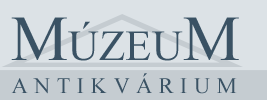kategóriák
- Közlekedés ajánlójegyzék
- Szocreál ajánlójegyzék
- Reklám ajánlójegyzék
- Fotó ajánlójegyzék
- Kínai-japán ajánlójegyzék
- Szentkép ajánlójegyzék
Új árakkal! - Új szentkép ajánlójegyzék II.
- 12 érdekes régiség
 Könyv
Könyv
 Bibliofilia
Bibliofilia
 Régiség
Régiség
 Metszet
Metszet
 Térkép
Térkép
 Fotó
Fotó
 Papírrégiség, Aprónyomtatvány
Papírrégiség, Aprónyomtatvány
 Plakát
Plakát
- Cirkusz
- Modern grafika
- Szocreál
- NER Irodalom
- Egyéb
kosár
üres a kosár
nincs bejelentkezve
Haag, Sabine (Hrsg.) : Die Welt von Fabergé
- leírás
- további adatok
Aranyozott lapélekkel.
Exhibition catalogue.
The name Fabergé conjures up exceptional creations, virtuoso craftsmanship that combines outstanding artistic and technical skill with the finest materials. This is particularly true of the work produced by Peter Carl Fabergé following his appointment as court jeweller to the last Russian Tsar in 1885. Under him the House of Fabergé grew into one of the largest contemporary jewellery companies, at times employing over five hundred goldsmiths, stone cutters and jewellers from different countries. The company worked for the imperial Russian court and other European dynasties, for the nobility, plutocrats and financial magnates, but they also produced less exalted work designed for the Russian bourgeoisie. Over 160 loans from the Kremlin Museums and the Fersman Mineralogical Museum in Moscow showcase Fabergés virtuosity, placing him in the context of contemporary Russian goldsmith work; another focus is the role of the imperial family. Four Imperial Easter eggs form the centre of the show - precious objets dart commissioned by the Imperial family that frequently contain a world en miniature, a microcosm. Other artefacts that once belonged to members of the House of Romanov, treasured possessions that stayed with them until their final days, offer fascinating insights into life, both private and ceremonial, at the imperial court. We also showcase hardstone carvings by Fabergé and the imperial manufactories at Petergof and Yekaterinburg, documenting the continued popularity in late-nineteencentury Russia of an art form closely connected with Kunstkammer collections.
Aus Anlass des 90. Jahrestages der Aufnahme diplomatischer Beziehungen zwischen der UdSSR/Russland und Österreich und des 525. Jahrestages der ersten diplomatischen Kontakte zwischen Moskau und Wien widmet das Kunsthistorische Museum im Rahmen der Russisch-Österreichischen Kultursaisonen 2013-2015 dem wohl bedeutendsten und einflussreichesten russischen Juwelier und Goldschmied der Wende vom 19. zum 20. Jahrhundert eine umfangreiche Ausstellung: Peter Carl Fabergé.
Mit dem Namen Fabergé verbindet man außergewöhnliche Schmuckkreationen, virtuoses, mit höchstem gestalterischem und technischem Können aus edelsten Materialien gefertigtes Kunsthandwerk. Das gilt insbesondere für jene Werke, die Peter Carl Fabergé ab 1885 als kaiserlicher Hoflieferant für die letzten russischen Kaiser schuf.
Exhibition catalogue.
The name Fabergé conjures up exceptional creations, virtuoso craftsmanship that combines outstanding artistic and technical skill with the finest materials. This is particularly true of the work produced by Peter Carl Fabergé following his appointment as court jeweller to the last Russian Tsar in 1885. Under him the House of Fabergé grew into one of the largest contemporary jewellery companies, at times employing over five hundred goldsmiths, stone cutters and jewellers from different countries. The company worked for the imperial Russian court and other European dynasties, for the nobility, plutocrats and financial magnates, but they also produced less exalted work designed for the Russian bourgeoisie. Over 160 loans from the Kremlin Museums and the Fersman Mineralogical Museum in Moscow showcase Fabergés virtuosity, placing him in the context of contemporary Russian goldsmith work; another focus is the role of the imperial family. Four Imperial Easter eggs form the centre of the show - precious objets dart commissioned by the Imperial family that frequently contain a world en miniature, a microcosm. Other artefacts that once belonged to members of the House of Romanov, treasured possessions that stayed with them until their final days, offer fascinating insights into life, both private and ceremonial, at the imperial court. We also showcase hardstone carvings by Fabergé and the imperial manufactories at Petergof and Yekaterinburg, documenting the continued popularity in late-nineteencentury Russia of an art form closely connected with Kunstkammer collections.
Aus Anlass des 90. Jahrestages der Aufnahme diplomatischer Beziehungen zwischen der UdSSR/Russland und Österreich und des 525. Jahrestages der ersten diplomatischen Kontakte zwischen Moskau und Wien widmet das Kunsthistorische Museum im Rahmen der Russisch-Österreichischen Kultursaisonen 2013-2015 dem wohl bedeutendsten und einflussreichesten russischen Juwelier und Goldschmied der Wende vom 19. zum 20. Jahrhundert eine umfangreiche Ausstellung: Peter Carl Fabergé.
Mit dem Namen Fabergé verbindet man außergewöhnliche Schmuckkreationen, virtuoses, mit höchstem gestalterischem und technischem Können aus edelsten Materialien gefertigtes Kunsthandwerk. Das gilt insbesondere für jene Werke, die Peter Carl Fabergé ab 1885 als kaiserlicher Hoflieferant für die letzten russischen Kaiser schuf.
| állapot: |      |
| kategória: | Könyv > Művészet > |
| kategória: | Könyv > Művészet > Iparművészet > |
| kategória: | Könyv > Művészet > Képzőművészet > kiállítási katalógus > |
| kategória: | Könyv > Idegennyelvű könyvek > Német nyelvű > |
| kiadó: | Kunsthistorisches Museum, 2014 |
| cikkszám / ISBN: | 9783990200575 |
| kötés: | fűzve |
| oldalszám: | 191 |
| könyv nyelve: | német |










 Telefon:
Telefon: E-mail:
E-mail:







